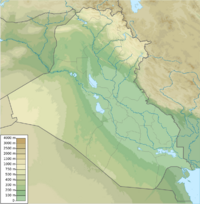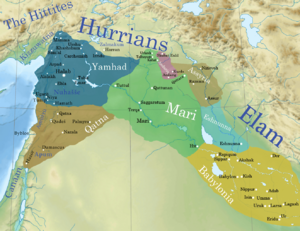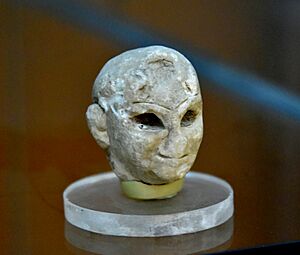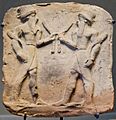Eshnunna facts for kids
| Alternative name | Tell Asmar |
|---|---|
| Location | Iraq |
| Coordinates | 33°29′3″N 44°43′42″E / 33.48417°N 44.72833°E |
| Type | settlement |
| History | |
| Founded | Late 4th Millennium BC |
| Periods | Bronze Age |
| Cultures | Early Dynastic, Akkadian, Ur III, Isin-Larsa, Old Babylonian |
| Site notes | |
| Excavation dates | 1930 to 1936, late 1990s |
| Archaeologists | Henri Frankfort, Seton Lloyd, Thorkild Jacobsen |
| Condition | Ruined |
| Ownership | Public |
| Public access | Yes |
Eshnunna (today called Tell Asmar) was an ancient city in Mesopotamia. It was located in what is now the Diyala Governorate in Iraq. This city was a big part of the Sumerian culture, even though it was a bit northwest of Sumer itself. Later, it became part of the Akkadian Empire.
People in Eshnunna worshipped several gods. The main god of the city was Tishpak. Other gods like Sin, Adad, and Inanna were also important.
Contents
A Look at Eshnunna's History
Early Times: Bronze Age Beginnings
Eshnunna has been lived in since about 3000 BC, during a time called the Jemdet Nasr period. It grew into a very important city during the Early Dynastic period.
Even though the city was smaller, people also lived there during the Akkadian period. Archaeologists found some of the earliest examples of sewage systems in the Northern Palace from this time. This included toilets in people's homes!
The first known rulers of Eshnunna were governors who worked for the Third dynasty of Ur. These governors had a special connection to the royal family. For example, the wife of King Shulgi showed respect to goddesses linked to Eshnunna's rulers.
Later, a governor named Ituria built a temple for King Shu-Sin. After Shu-Sin died, Ituria's son, Shu-iliya, became ruler. In 2026 BCE, he changed the calendar and stopped calling himself a governor. Instead, he called himself a lugal (king) and said he was "beloved of Tishpak". His special seal showed him with the god Tishpak. Rulers after him would call themselves "stewards" of Eshnunna for Tishpak.
Middle Bronze Age: Rising to Power
After the Ur III empire fell, many city-states fought for control. Eshnunna was briefly controlled by a group called Subartu. But then, Ishbi-Erra from the city of Isin defeated them. He made Nurahum the new king of Eshnunna.
The city became a major power during the rule of Ipiq-Adad II. He brought back the title of king and even claimed to be a god himself.
Around the 19th century BC, Eshnunna and Babylon, led by Sumu-la-El, became very strong. They both tried to control more land. Apil-Sin of Babylon expanded his control, but Naram-Sin of Eshnunna took some of that land back. Naram-Sin was also the one who forced Shamshi-Adad I into exile.
Dadusha, a king of Eshnunna, attacked Shamshi-Adad I. But Shamshi-Adad fought back, and they made a peace treaty in 1782 BCE. Dadusha then worked with Shamshi-Adad on a military campaign.
After Shamshi-Adad died, his kingdom broke apart, and many cities became independent again. Ibal-pi-el II of Eshnunna tried to make an alliance with Zimri-Lim of Mari, with Eshnunna in charge. But their relationship quickly broke down. Zimri-Lim then worked with Hammurabi of Babylon.
Ibal-pi-El also captured other cities and expanded Eshnunna's power to the north. He even took over Assur and Shubat-Enlil.
At this time, the world was very complicated. A record from Mari said:
"No king is truly powerful just on his own: ten to fifteen kings follow Hammurabi of Babylon, as many follow Rim-Sin of Larsa, as many follow Ibal-pi-El of Eshnunna, and as many follow Amut-pi-El of Qatna; but twenty kings follow Yarim-Lim of Yamhad"
However, Eshnunna soon lost its power. The Elamite ruler Siwe-Palar-Khuppak attacked Eshnunna. Zimri-Lim and Hammurabi helped the Elamites. Elam then conquered more cities and even made Babylon and Larsa fight each other. Eventually, Hammurabi led a group that stopped Elam's plans.
Eshnunna was looted by the Elamite soldiers. The city's army then made Silli-Sin, a common person, their new king. Silli-Sin made a treaty with Hammurabi and married one of Hammurabi's daughters. But soon, Eshnunna and Babylon had problems again.
In 1762 BC, Hammurabi's army took over Eshnunna. He returned the main god of Assur, which Eshnunna had taken when they captured Assur. In his 38th year as king, Hammurabi claimed he destroyed Eshnunna with a flood.
Late Bronze Age: Trade and Decline
In the 12th century BC, the Elamite ruler Shutruk-Nakhunte conquered Eshnunna. He took many statues from the city back to Susa, his capital.
Eshnunna was important because it controlled valuable trade routes. It was a bridge between Mesopotamian and Elamite cultures. Through these routes, Eshnunna got many interesting goods. These included horses from the north, and metals like copper and tin. They also got precious stones. In one grave, a pendant made of copal from Zanzibar was found! A few seals and beads from the Indus Valley civilization were also discovered. This shows how far Eshnunna's trade connections reached.
Exploring Eshnunna: Archaeology
The ancient city of Eshnunna is now a large mound of ruins called Tell Asmar. It is about 50 miles northeast of Baghdad.
Archaeologists from the Oriental Institute at the University of Chicago excavated the site. They worked there for six seasons between 1930 and 1936. Famous archaeologists like Henri Frankfort, Thorkild Jacobsen, and Seton Lloyd were part of the team.
The main focus of the excavations was a large palace and a temple next to it. The palace was built by King Shulgi, and the temple was built by Governor Ituria for King Su-Sin. The palace was partly destroyed but later rebuilt.
Archaeologists also worked on the Abu Temple, which was very old, dating back to the Early Dynastic I period. They found a large building from the time of Ipiq-Adad II, but only its foundations remained. Several private houses and a palace from the Akkadian period were also dug up. The team also searched for the temple of Tishpak, called E-sikil, but they didn't find it.
Even today, researchers are still studying and publishing the finds from these old excavations at Tell Asmar.
These finds include clay figures, toys, necklaces, and cylinder seals. They also found about 1,750 cuneiform tablets. These tablets are made of clay and have ancient writing on them. Many tablets were damaged during the digging because the workers were not experienced. A project to clean and catalog all the tablets didn't happen until the 1970s.
Most of the tablets from Eshnunna are about daily administration. But 58 of them are letters, which are rare for this time. These letters are written in an early form of the Akkadian language.
In the late 1990s, Iraqi archaeologists also worked at Tell Asmar. Their findings have not been published yet.
The Square Temple of Abu
The Abu Temple at Tell Asmar changed a lot over time during the Early Dynastic period. It had different building phases, including the Archaic Shrine, Square Temple, and Single-Shrine.
A special discovery was made in the Square Temple: a group of 12 gypsum statues. These statues are known as the Tell Asmar Hoard. They are some of the most famous examples of ancient Near East sculpture. The statues, which are now in different museums, show gods, priests, and people who donated to the temple. They are all in a simple, geometric style. All the figures have very large, inlaid eyes. The tallest statue, which shows the local god, has enormous eyes that make it look very powerful.
The Laws of Eshnunna
Eshnunna had its own set of laws, similar to the famous Code of Hammurabi. These laws were found on two clay tablets and a small piece of another tablet. They were written around the time of King Dadusha of Eshnunna. We don't know exactly when the laws were first created.
Here is an example of one of the laws:
"If a man begat sons, divorced his wife and married another, that man shall be uprooted from the house and property and may go after whom he loves. His wife (on the other hand) she claims the house."
This law shows how important family and property were in ancient Eshnunna.
Rulers of Eshnunna
We don't know the names of the earliest rulers from the Early Dynastic period or the governors under the Akkadian empire. For a while, Eshnunna was ruled by governors who served the Ur III empire. Then, it became independent with its own kings for several centuries. After Hammurabi captured the city, it was again ruled by governors who served Babylon. The city continued to exist until at least the 12th century BC, but we don't know who ruled it after that.
| Portrait or inscription | Ruler | Approx. dates | Comments, notes, and references for mentions |
|---|---|---|---|
| Urguedinna | Uncertain; these rulers may have r. c. 2247 – c. 2030 | These four ruled as governors for Shulgi of the third dynasty of Ur. | |
| Bamu | |||
| Kallamu | |||
| Lugal-Kuzu | |||
| Ituria | r. | Governor under Shu-Sin of the third dynasty of Ur. Known from a temple dedication. | |
| DIlushuilia | r. | He was treated like a god. | |
| Nurakhum | r. | Ruled during the time of Ibbi-Sin of Ur and Ishbi-Erra of Isin. | |
| Kirikiri | Uncertain; these rulers may have r. c. 2010 – c. 1950 | ||
| Bilalama | Son of Kirikiri. His daughter married a ruler from Elam. | ||
| Isharramashu | Uncertain; may have r. c. 1950 – c. 1940 | ||
| Usurawassu | r. | ||
| Anum-muttabil | Uncertain; these rulers may have r. c. 1940 – c. 1895 | ||
| Abimadar | |||
| Azuzum | |||
| Urninmarki | |||
| Urningizzida | |||
| Ipiq-Adad I | Ruled during the time of Sumu-abum of Babylon. | ||
| Abdi-Erah | |||
| Shiqlanum | |||
| Sarriia | r. | ||
| Warassa | Uncertain; these rulers may have r. c. 1895 – c. 1870 | ||
| Belakum | |||
| Ibal-pi-El I | r. | Built a throne decorated with gold and pearls. | |
| DIpiq-Adad II | r. c. 1857 – c. 1817 | Ruled for at least 36 years. He was the first ruler of Eshnunna to call himself king and was treated like a god. | |
| DNaram-Suen | r. c. 1816 – c. 1798 | Son of Ipiq-Adad II. Ruled during the time of Shamshi-Adad I of Assyria. He was treated like a god. | |
| Dannum-tahaz | r. c. 1797 – c. 1792 | Approximate time. | |
| Ibni-Erra | Uncertain; these rulers may have r. c. 1792 – c. 1790 | ||
| Ibbi-Suen | |||
| Dadusha | r. c. 1790 – c. 1780 | Son of Ipiq-Adad II. Ruled during the time of Shamshi-Adad I of Assyria. | |
| Ibal-pi-el II | r. c. 1779 – c. 1765 | Son of Dadusha. Ruled during the time of Zimri-Lim of Mari. He was killed by Siwe-Palar-Khuppak of Elam. | |
| Silli-Suen | r. c. 1763 – c. 1756 | Made a treaty with Hammurabi. In his 4th year, he married Hammurabi's daughter. | |
| Iqishi-Tishpak | r. c. 1756 – c. 1742 | ||
| Iluni | r. c. 1742 – c. 1736 | Ruled under Babylon during the time of Samsu-iluna. | |
| Anni | r. | ||
| Ahu-šina | r. | ||
Images for kids
See also
- List of cities of the ancient Near East
- Khafajah
- Tell Ishchali
- Chronology of the ancient Near East
- Mari
- Andarig
















